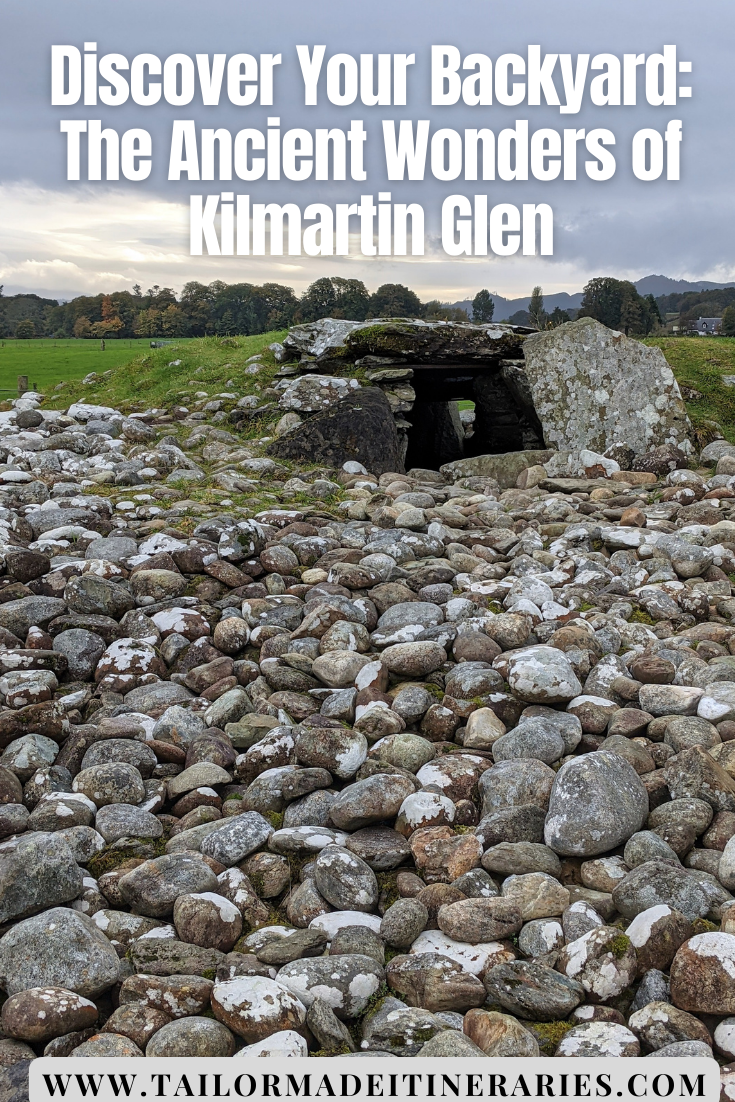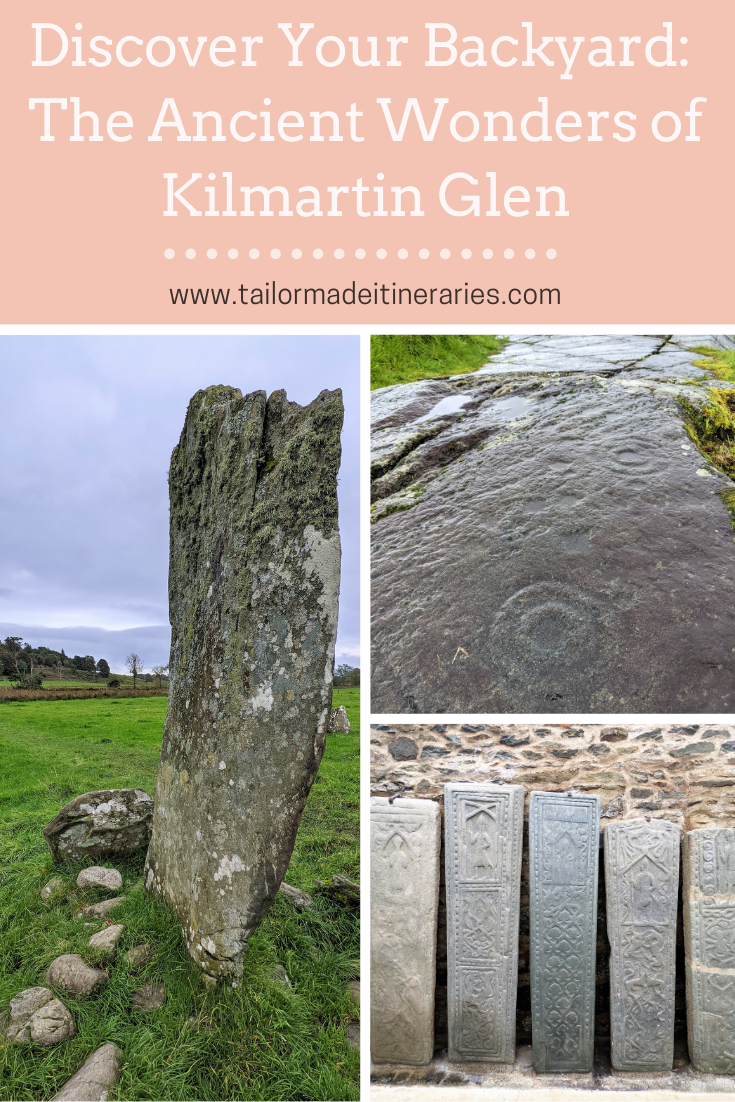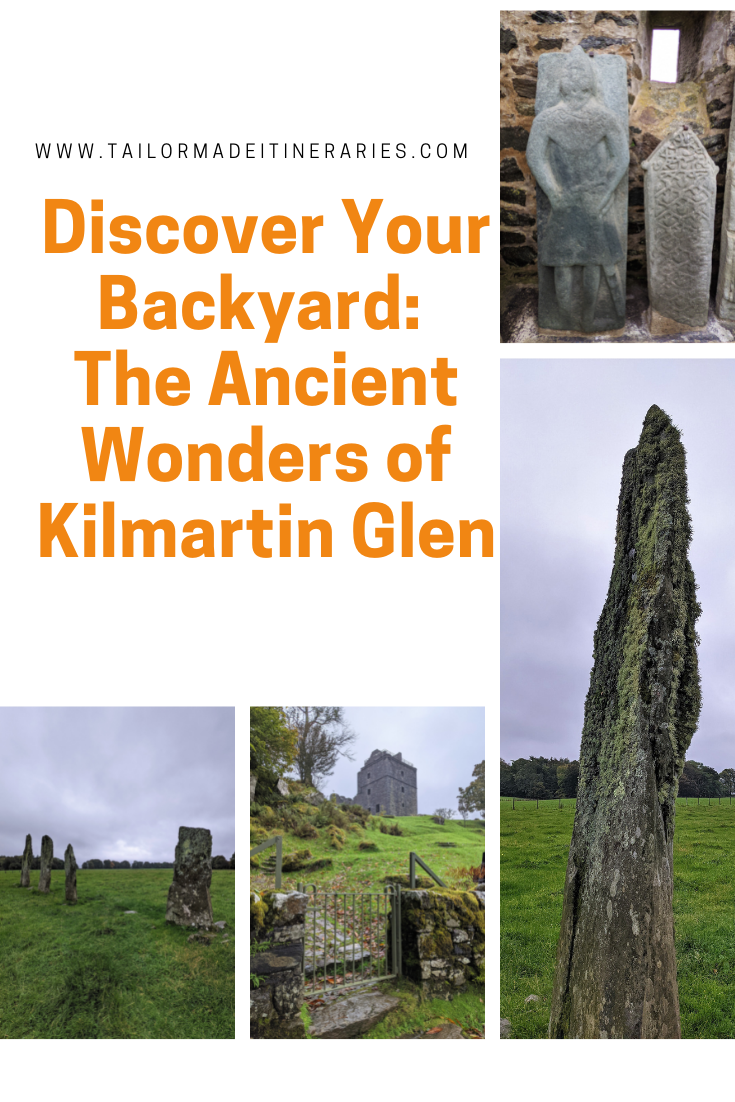
**Disclosure: This post contains affiliate links. Regardless of this, please be advised that all opinions expressed in this blog post are genuine and authentically my own.**
Author: Barry Pickard
Scotland is a land of myths and legends, with landscapes full of ancient mysteries. Stone circles, cairns, and carved stones can be found throughout the country. The highest concentration of these prehistoric marvels, however, are to be found in Kilmartin Glen, Argyll, less than an hour’s drive south from Oban. Indeed, there are an estimated 800 ancient monuments within a six-mile (ten-kilometre) radius of the village of Kilmartin!
The majority of these Neolithic, Bronze & Iron Age, and early medieval remains may only be of specialist interest, but there is still a fascinating collection of historical sites to visit that will astound and amaze all visitors to Kilmartin Glen. Read on to discover the impressive sites that we managed to visit just in one day.

Don’t forget that Tailor-Made Itineraries delights in creating bespoke self-guided tours. So, if visiting Kilmartin appeals to you, reach out to me by email. I would be more than happy to design a self-guided tour around your requirements incorporating the ancient sites of Kilmartin Glen, or indeed, a general tour of Argyll or Scotland.
Carnasserie Castle
Approaching Kilmartin Glen from the north, the first impressive attraction that you come to is Carnasserie Castle. This impressive fortification which dominates the narrow valley below, was built between 1565 and 1572. The Castle was built for John Carswell who later became Bishop of the Isles. There is a fine view of Kilmartin Glen from the ramparts.
Tailor-Made Top Tip: The Dalriada Heritage Trail, a seven-mile walk that leads to Dunadd Fort and the Crinan Canal, starts at Carnasserie Castle.
Kilmartin Museum
Unfortunately, the Kilmartin Museum was closed for renovations and the building of an extension when we visited the glen. The museum is due to reopen in 2023 and is sure to become a must visit attraction of the area. The museum interprets the Neolithic monuments of Kilmartin Glen and the surrounding area and has a selection of excavated artefacts of various periods.
Tailor-Made Top Tip: Even though currently closed, the museum still organises guided walks on Wednesdays (seasonally dependent). Click here for more information and to book your place.
Update: The museum reopened in September 2023!
Kilmartin Church & Graveyard
When visiting Kilmartin Museum, make sure to check out the graveyard of Kilmartin Church, which is home to over 23 fine sculptured stones, ranging in date from the 900s to the 1600s. Together, they’re testament to the long history of Kilmartin Glen and hint at a much longer history of religious activity at Kilmartin. The collection is possibly connected to the nearby medieval power centre at Dunadd Fort.
Tailor-Made Top Tip: There is a small shelter in the graveyard, which houses many of the best examples of sculptured stones.
If you are enjoying this post, remember and subscribe to my mailing list to receive my latest blog posts.
Glebe Cairn
In the fields behind Kilmartin Museum, is the Glebe Cairn. This is the northernmost of the five burial cairns that line the valley floor in Kilmartin Glen. The cairns of the ‘linear cemetery’ all date to between 5,000 and 3,500 years ago and seem to be associated with the other prehistoric monuments of the glen. Excavations at Glebe Cairn have revealed a long history of ritual activity. At the centre, two concentric rings of boulders, with a burial cist inside, may be the earliest part of the structure.
Tailor-Made Top Tip: As with many of the prehistoric attractions in this glen, they tend to be in fields that can get quite muddy, so make sure to wear appropriate footwear!

Kilmartin Hotel
The Kilmartin Hotel can be found opposite the museum and church, and we found that it was a great place to stop for a hearty dinner following all our explorations of the glen.
Tailor-Made Top Tip: There are few dining options in and around Kilmartin Glen, so wherever you go for a meal, we’d always recommend making a reservation to avoid disappointment.
Nether Largie Cairns – North, Mid & South
Nether Largie North Cairn is the next large burial cairns that forms the ‘linear cemetery’ along Kilmartin Glen. Like the others, it is a large round cairn, dating to around 5,000–3,500 years ago. Study of its central cist revealed a fascinating discovery on its capstone – about 40 cup and ring marks, and pecked carvings of two axe-heads. Could this be re-use of an even older standing stone?
Of a similar age is the Nether Largie Mid Cairn. This too has some rare axe-head carvings in one of the cairn’s two cists, suggesting that this was the burial place of a high-status individual: axes were an indicator of wealth.
Probably the oldest of the Nether Largie cairns is the South Cairn, which was likely built over 5,000 years ago. The original chamber at its centre was divided into four compartments and probably held numerous burials, in line with Neolithic practices. As with the other monuments in Kilmartin Glen, the site continued to be used as a sacred place. At some point about 4,000 years ago the cairn was enlarged into a 30m-wide round cairn, to accommodate two secondary cists, or stone coffins – doubtless to house the remains of chiefs.
Temple Wood Stone Circle
Continuing south from the cairns, you will find Temple Wood Stone Circle beyond a low stone wall that runs along the road. The circle was built some time before 3000 BC and continued into the Bronze Age, ending about 1000 BC. In that time, it was used as a place for ritual ceremonies and funerary activity. Today its most immediately visible feature is 13 standing stones. One is marked with a spiral, a motif closely paralleled in Irish passage-grave art.
Tailor-Made Top Tip: There are actually two stone circles at this site, although only one is quite prominent.
If you are enjoying this post, remember and subscribe to my mailing list to receive my latest blog posts.
Nether Largie Standing Stones
The six impressive Nether Largie Standing Stones are laid out in a cross, and some are almost 3 metres tall. All but one of the stones are cup-marked, with some of these markings being very prominent.
Tailor-Made Top Tip: There is a carpark at the junction of the A816 and B8025 roads which is only a two-minute walk from the stones.
Baluachraig Cup and Ring Marks
The rock art at Baluachraig is made up of simple hollows, cups and rings, and is quite beautiful in its simplicity. Their meaning remains a mystery, but these marks are some of the most ancient artefacts to be found in the glen.
Tailor-Made Top Tip: The rock art can be accessed from a path that runs parallel to the main road.
Dunchraigaig Cairn
Dunchraigaig Cairn, like most of the other Bronze Age cairns in Kilmartin Glen, it is a large, round burial mound about 4,000 years old. It is unusual on the inside, with excavations in the 1800s finding the remains of up to 10 individuals in one cist, dug directly into the ground and capped with a massive 3.8m stone.
Tailor-Made Top Tip: There is a small carpark on the opposite side of the from the cairn.
Ballymeanoch Standing Stones
The Ballymeanoch Standing Stones are impressively tall, with the tallest being over 4 metres high. In two rows of four and two stones each, the standing stones are also joined by a smaller stone circle, as well as a henge with a small burial cairn. Over 4,000 years old, the standing stones also have a number of cup and ring marks.
Tailor-Made Top Tip: The stones can be accessed via a path from the Dunchraigaig Cairn or a path directly to the main road.
If you are enjoying this post, remember and subscribe to my mailing list to receive my latest blog posts.
Kilmichael Glassary Cup and Ring Marks
Kilmichael Glassary’s carvings are unique among the many rock art sites in Kilmartin Glen. They’re characterised by the large cup marks with long stretches of gutter, and, unusually, at least four keyhole-shaped marks. There are also at least 47 plain cup marks, or circular hollows in the stone, and five cups with single rings. The carvings are abstract and contain no animal or human figures.
Tailor-Made Top Tip: The atmospheric Kilmichael Parish Church and its graveyard which are near the stone carvings are worth a quite investigation.
Dunadd Fort
This rocky crag was first fortified around 2,400 years ago and in the 6th century AD become the citadel of the Kings of Dál Riata, the first Kings of Scotland. This was the home of the Scotti, the people who gave Scotland its name.

Dunadd Fort became a major political centre, making contacts and alliances with other major kingdoms of the day. It was also a centre of trade and imported many goods such as dyes from France, exotic spices and wines. Shallow drafted ships negotiated the River Add, connecting the Kings of Dál Riata with the rest of Europe.
The climb up to the fort and its citadel is not for the faint-hearted and a lot of care should be taken in the ascent, but despite a few tricky parts, it only takes five-minutes or so to reach the summit.
Tailor-Made Top Tip: Look out for the stone slap near the summit which has a footprint sized indentation. This was where the first Kings of Scotland were inaugurated.
Where to Stay near Kilmarting Glen
During our visit, we opted to stay at the Clan Cottages, in the idyllic Kilmore, just south of Oban. There is a selection of well-appointed self-catering cottages on the shores of Loch Nell and they are an ideal base from which to explore Oban and the surrounding countryside.

Alternatively, there are a number of options in Oban itself, such as the Dungallan Country House Bed & Breakfast, the Muthu Alexandra Hotel, and No17 The Promenade.
If you would rather book something a bit closer to the glen (it takes just under an hour to drive from Oban to the glen), look no further than the Crinan Hotel. or stay in the afforementioned Kilmartin Hotel.
Conclusion
All of the prehistoric sites mentioned were easily visited during a day trip from Oban. Within the glen itself, we used a mixture of walking and driving by car to see all these sites. There are plenty more ancient wonders to uncover and if you think that you would enjoy walking through the fields and hills of the glen, you could probably spend another day or two exploring this fascinating area.
Related Blog Posts
If you are interested in finding out more about ancient Scotland, please view the Tailor-Made Itineraries posts below:
If you are interested in finding out more about the Argyll and Bute region of Scotland, please view the Tailor-Made Itineraries posts below:
Comment below and let us know what is your favourite ancient Scottish attraction?
Don’t forget that Tailor-Made Itineraries delights in creating bespoke self-guided tours. So, if visiting Kilmartin appeals to you, reach out to me by email. I would be more than happy to design a self-guided tour around your requirements incorporating the ancient sites of Kilmartin Glen, or indeed, a general tour of Argyll or Scotland.
Tailor-Made Itineraries posts every two weeks, and you can subscribe to the latest blog and newsletter here. Until then, happy reading and safe travels.
Barry
Contact Me: tailoritineraries@gmail.com
Tailor-Made Itineraries creates one-of-a-kind bespoke self-guided travel itineraries for adventurous and curious travellers.
These self-guided tours deliver a personalised and exciting holiday experience that takes the effort out of trip planning.





























































































































































Comments